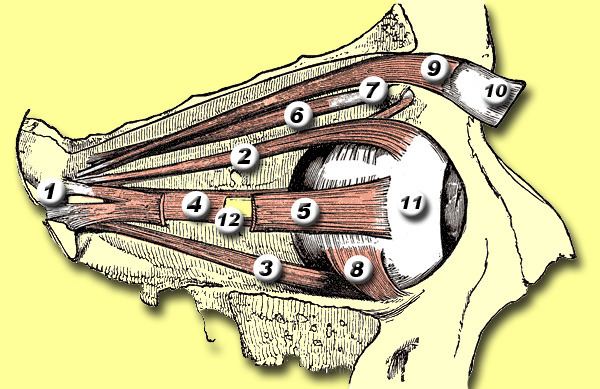Artery ophthalmic artery | ||
 | ||
Insertion laterally onto the eyeball, deep to the lateral rectus, by a short flat tendon Actions extorsion, elevation, abduction Latin musculus obliquus inferior bulbi | ||
The inferior oblique muscle or obliquus oculi inferior is a thin, narrow muscle placed near the anterior margin of the floor of the orbit. The inferior oblique is an extraocular muscle, and is attached to the maxillary bone (origin) and the posterior, inferior, lateral surface of the eye (insertion). The inferior oblique is innervated by the inferior branch of the oculomotor nerve.
Contents
Structure
The inferior oblique arises from the orbital surface of the maxilla, lateral to the lacrimal groove. Unlike the other extraocular muscles (recti and superior oblique), the inferior oblique muscle does not originate from the common tendinous ring (annulus of Zinn).
Passing lateralward, backward, and upward, between the inferior rectus and the floor of the orbit, and just underneath the lateral rectus muscle, the inferior oblique inserts onto the scleral surface between the inferior rectus and lateral rectus.
In humans, the muscle is about 35 mm long.
Innervation
The inferior oblique is innervated by the inferior division of the oculomotor nerve (cranial nerve III).
Function
Its actions are extorsion, elevation and abduction of the eye.
Primary action is extorsion (external rotation); secondary action is elevation; tertiary action is abduction (i.e. it extorts the eye and moves it upward and outwards). The field of maximal inferior oblique elevation is in the adducted position.
The inferior oblique muscle is the only muscle that is capable of elevating the eye when it is in a fully adducted position.
Clinical significance
While commonly affected by palsies of the inferior division of the oculomotor nerve, isolated palsies of the inferior oblique (without affecting other functions of the oculomotor nerve) are quite rare.
"Overaction" of the inferior oblique muscle is a commonly observed component of childhood strabismus, particularly infantile esotropia and exotropia. Because true hyperinnervation is not usually present, this phenomenon is better termed "elevation in adduction".
Surgical procedures of the inferior oblique include: loosening (also known as recession see Strabismus surgery), myectomy, marginal myotomy, and denervation and extirpation. It is also encountered and identified in lower lid blepharoplasty surgeries.
